The Early Dynastic Period
Dynasties 1-2
(~ 3.200 - 2.649 BC)
By Ottar Vendel
2920 - 2770 BC (150 years)
In the archaeology column in the table below Narmer has been put in according to the traditional results from excavations and records, the latest being a couple of king lists on seals found in the cemetery in Abydos in the 1990s. Manetho's kings are followed by the figures of the duration of their reigns. The names in general are in some cases not quite corresponding, but the underlined ones (in black) seem to match quite well.
| Archaeology | Manetho (Africanus) | Abydos list |
Turin canon |
| 1 Narmer | 1 Menes 62 | 1 Meni | 1 Meni |
| 2 Aha | 2 Athothis 57 | 2 Teti | 2 Iteti |
| 3 Djer | 3 Kenkenes 31 | 3 Ateth | 3 - |
| 4 Djet, Wadji | 4 Uenephes 23 | 4 Ati | 4 Itiui |
| 5 Den, Semti, Udimu | 5 Usaphaidos 20 | 5 Hesepti | 5 Semti |
| 6 Anedjib, Enezib, Merbap(-en) | 6 Miebidos 26 | 6 Merbap | 6 Merbiapen |
| 7 Semerkhet, Semsem | 7 Semempses 18 | 7 Hu | 7 Semsem |
| 8 Qáa | 8 Bieneches 26 | 8 Queb | 8 (Ke-) behu |
| (? Bird) | |||
| (? Sneferka) |

Meni - Teti - Iti - Ita - Septi - Merbiap - Semsu - Kebh
The names of the dynasty one pharaohs from the Abydos king list.
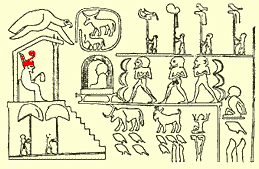 |
| Scene from a mace head where Narmer sits on his throne wearing the red crown of Lower Egypt and being offered a bride? sitting in a canopy in front of him. |
Pharaoh Narmer has for some reason always been put outside the dynasty scheme, but the Egyptians themselves from the very beginning recorded him as their very first king and there is no reason not to give him prime position in the line of rulers.
His fame comes from a big ceremonial siltstone palette which was found in 1895 under ground in the temple yard of the old town Hierakonpolis.
It is nowadays a big attraction in the Egyptian Museum in Cairo.
In the first years of the 1900s his tomb was excavated by the famous English Egyptologist Flinders Petrie at the cemetery in Abydos, the oldest royal burial ground known in Egypt. In the 1980s the site was once again by German Egyptologists, and another tablet depicting Narmer was found. Sereks with his name has been found throughout the country and a lot of them in Tarkhan slightly south of the first capital of the whole Egypt - Memphis. A catfish (Nar) and a chisel (mer) made up his name, but there existed several variations, possibly the writers' way to make the readers pronounce the name correctly.
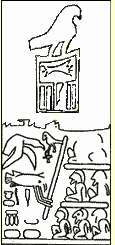
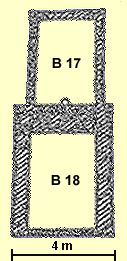 He could well have been named Narbe- djau or something similar. The picture left
has his name in a serek, and he is seen as a catfish giving the enemies a hard time with a
cudgel.
His name does not appear in later king lists, though he had so many written remains during
his lifetime. Many of them are found on jars in grave from Tarkhan, the possibly last
stronghold for the southern kings of Thinis before the final push northwards to make the
revolution complete by uniting the northern (Lower) part of the country to his home land in the south - Upper Egypt. This might indicate that his reign was prior to Menes, the legendary unifier of the two Egyptian lands accor- ding to the Egyptian historian Manetho, living in the 200s BC and writing in Greek.
He could well have been named Narbe- djau or something similar. The picture left
has his name in a serek, and he is seen as a catfish giving the enemies a hard time with a
cudgel.
His name does not appear in later king lists, though he had so many written remains during
his lifetime. Many of them are found on jars in grave from Tarkhan, the possibly last
stronghold for the southern kings of Thinis before the final push northwards to make the
revolution complete by uniting the northern (Lower) part of the country to his home land in the south - Upper Egypt. This might indicate that his reign was prior to Menes, the legendary unifier of the two Egyptian lands accor- ding to the Egyptian historian Manetho, living in the 200s BC and writing in Greek.
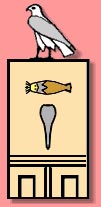 Horus Narmer |
Narmer's first queen was named Neit-Hotep and her great big mastaba tomb at Nagada wich by far out-measured his own very modest monument. He is the presumed father of the next pharaoh to be - Aha, who had his large tomb complex built just a few meters away and probably was the builder of his mother's tomb as well.
Why her monument was built far south in Nagada (100 km downstream the Nile) is a question not fully solved, but might indicate Narmer's place of residence.
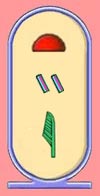 Iti |
 Pharaoh Aha had the personal nomen Iti seen within the cartouche left taken from the Turin Canon. He is by tradition among archaeologists the pharaoh who founded the first dynasty and a long reign and monuments and other remains attested to him have been found all over Egypt.
Pharaoh Aha had the personal nomen Iti seen within the cartouche left taken from the Turin Canon. He is by tradition among archaeologists the pharaoh who founded the first dynasty and a long reign and monuments and other remains attested to him have been found all over Egypt. If he was the first king (by the historian Manetho called Menes) he was supposed to have been in office for 62 years. He was an active ruler who put forward the god Ptah from the new capital Memphis. This town (or actually a shrine within it) had the indigenous name "Hiku-Ptah" which later was corrupted by foreigners to "Egypt".
All forms of craftsmanship and art was supported during his rule, and he was a reconciler between the two fractions in the country after the Upper (southern) part's taking over of the Lower (northern).
Manetho says that during this time the Egyptian people learned how to live in a civilized manner, and worship the gods in a proper way. The first great mastaba tomb at Sakkara (the royal cemetery of Memphis) is from Aha's reign (Nr 3357, c. 42x15 m), and was the first ever to have a boat buried beside. This custom with maritime connection was to continue for thousands of years.
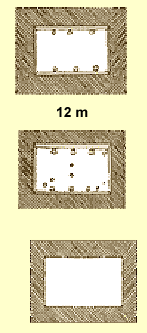
At the same site great mastabas were built for persons believed to have been high officials and probably close relatives to the king or his queen. Very few remains (if any) from king Aha are found outside Egypt and just a single find of foreign pottery is found from his reign.
A big change is shown in his tomb complex at Abydos, so different from his predecessors' and presumed father Nar- mer's. The main buildings are three chambers with very thick walls placed in a row (picture right). Like the other coming tombs they were lined inside with wood and roofed with wooden beams. Completing the row were 34 minor tombs for retainers who had followed their master into the next world. If they were sacrificed or buried over after their natural death, is not known. This indicates that Aha had a supreme and next to divine power, a heritage that should become the distinctive mark for the Egyptian state in the time to come.
The first chamber was the burial place of the king himself and there was found written text of a cargo freight to the Delta with offering goods to a shrine, all carved in to a tiny little label of wood. The second chamber is believed to belong to his queen named Bernerib (meaning "Sweet of Hearts"). Her name was found in some side burials probably belonging to her servants. This means that the complex was extended over time and investigations from the 1990s confirms that many royal tombs at Abydos was altered several times.
 King Djer had a long reign. Modern scientce says around 40 years partly based on the written records partly from the Palermo Stone and the Cairo Stone, (57 and 27 years acc- ording to two followers of the historian Manetho).
King Djer had a long reign. Modern scientce says around 40 years partly based on the written records partly from the Palermo Stone and the Cairo Stone, (57 and 27 years acc- ording to two followers of the historian Manetho). His time on the throne was a period of great prosperity in all aspects of society like art, craftsmanship, science and medicine, and the king had a personal reputation as a great physician and his writings about treatment of com- mon diseases was in use for 3000 years after his death.
The Cairo Stone tells about his campaign against a country named Setjet, probably Palestine or Sinai, which shows Egypt's increasing economical and political interests abroad. At Abydos his tomb (picture right) shows no big change compared to his predecessor Aha, but the general layout of the complex was altered and the number of subsidiary burials were over 300, a record for all pharaohs. Short inscriptions of titles in these tombs, have made it possible to reconstruct parts of the organization at the court. His grave chamber contained a dozen jars and pots imported from the region of Palestine and Syria. By a lucky strike a mummified arm wearing bracelets was found in his tomb at the excavation in 1901. The bones were unfortunately thrown away thereby making it impossible to detect if the remain was from a man, maybe from the king himself.
At the same site he started a tradition by making a big funeral enclosure for the cult of his immortal soul. An area of similar size two hundred meters to the west is still anonymous and might even be from his predecessor and father - king Aha.
Human sacrifice?
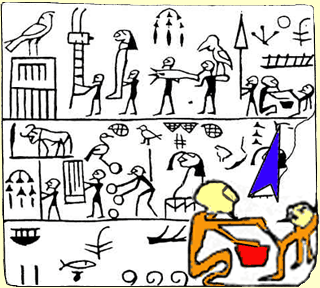
|
Among other objects was also found a small wooden label depicting a human sacrifice (picture left). A dagger is stuck into the chest of a bearded man who has his hands bound behind his back. A bowl (here in red) is held to catch the blood from the victim. A simi- lar scene is found on a frag- ment from an ivory label of pharaoh Aha found in Abydos. When looking at the motif on the label it seems to be a procession towards the serek with king Djer's name. In the top register men are carrying a ladder-looking object almost like those used to board fortified walls which have hooks atop. Thereafter comes a man holding an upright mummy-like figure and a man holding a catfish, which was the symbol of king Narmer, his supposed grandfather. Right over the fish is the hieroglyph for the sound M (like in Menes). Next in line is a man with a stork-like bird sitting on is left arm followed by a man carrying a standard looking object shaped like a gigantic arrow pointing to the sky. At the end comes she scene interpreted as a human sacrifice or possibly blood-letting.
In the next row the hieroglyph M is at front and a man holding a bull standard, the symbol of the king as the strong poten bull Apis. He is followed by a musician playing on a square shaped harp and a juggler using four balls. Upon the most lofty one sits a bird. Finally comes two doll like sitting statues(?) with some signs above.
Is this a depiction of a celebration with offerings in Narmer's mortuary cult? We do not know, but it is possible. Why is a mummy in the procession? Is it Narmer's mummified body being relocated from his original tomb to the more easy-to-guard royal cemetery at Abydos? If so this might explain why hi tomb there is so small and rather sloppy built, and not at all in the tandard of what is to be expected for a king of his magnitude. Relocations of at least grave offerings of his is known, like those found in the catch within the temple yard at Hierakonpolis and abviously brought there, like Narmer's famous palette and Scorpion's great mace head. They surely came from other tombs and the question is: where were those located?
Other finds from king Djer is a headless statuette found in a small temple on the island of Elephantine at Aswan in the south. It might be the oldest sculpture of this kind so far. It's a tiny figurine sitting on a throne with a sign at the side which can be read as DR - the consonants from king Djer's name (vowels were not written). Other places where his name has been found (apart from his tomb in Abydos) are: Tura, Sakkara and Helwan. The two latter being situated at each river bank at the capital Memphis where Helwan was the burial ground for the nobility not related to the royal court.
With his first queen Herneith he had the daughter Merneith (column left) who was married to the next king Djet and ruled after being a widow. King Djer's campaign into western Asia is attested for in domestic writing, but his name has not been found outside Egypt.
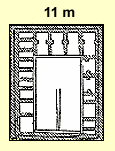 King Djet had variations of his name like Uadji and Zet, but Wadjet is probably the correct form. His personal nomen from the Abydos temple wall, Itiui, is shown within a cartouche in a picture at bottom right. His Horus-name was written by a single snake and has been his icon for historians in later times. Manetho gives a king called Kenkenes 31 years and one called Uenepes 23, and probably one of them is Djet, the latter one being the most likely.
King Djet had variations of his name like Uadji and Zet, but Wadjet is probably the correct form. His personal nomen from the Abydos temple wall, Itiui, is shown within a cartouche in a picture at bottom right. His Horus-name was written by a single snake and has been his icon for historians in later times. Manetho gives a king called Kenkenes 31 years and one called Uenepes 23, and probably one of them is Djet, the latter one being the most likely.
His tomb in Abydos (picture right) had a new feature - small rooms surrounding the grave chamber within the building itself, a feature similar to mastabas. From the same site he has left a masterpiece of Egyptian art from all times - a magnificent over two metre high stone stele found outside the tomb, now in the Louvre Museum in Paris. It was from the beginning erected at the spot marking the place where visitors cold give tribute to the memory of the dead pharaoh. The tomb itself had probably no visible part above ground in contrast to his ritual area by the Nile, with its high walls.
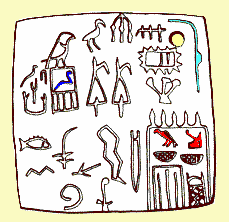
A year-label (left) came to light, showing the king's name and symbols of Upper and Lower Egypt - the vulture and the red crown.
Other monuments from Djet's reign are two large mastabas at Tarkhan and most of all a large mastaba from the capital's necropolis at Sakkara. It measures 20 by 50 meters and was excavated by English archaeologist Emery in 1953-56. It had over 400 bulls' heads sculptured with genuine horns all placed in straight rows around the walls, and beside it stood of over 60 side burials for retainers.
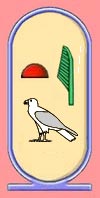 Itiui |
When English archaeologist Flinders Petrie re-excavated the tombs at the old burial ground of Abydos during 1901 he unexpectedly found an unknown tomb whose owner bore the name Mer-Neith.
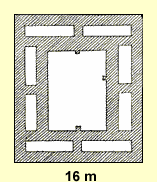 The monument itself was a traditional building under ground with side chambers within like the
mastaba tombs (picture left) accompanied with side burials of retainers outside.
The monument itself was a traditional building under ground with side chambers within like the
mastaba tombs (picture left) accompanied with side burials of retainers outside. At first he thought that he had found an unknown king, but soon new fact came to light telling the unexpected truth that Mer-Neith was a woman.
It became clear that she was the widow and queen of king Djet and held office during the childhood and youth of their son, the next ruler to be - king Den whose name appeared in the grave.
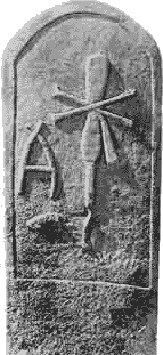 A proof of her position in the sequence of leaders was later found on a seal impression from the tomb of her son, where her name was put along with the ruling kings but without the king's insignia - the Horus falcon.
A proof of her position in the sequence of leaders was later found on a seal impression from the tomb of her son, where her name was put along with the ruling kings but without the king's insignia - the Horus falcon.In other lists from later times however, the Egyptians did not mention her, only her son. Above all, her name was found on a fine stele made of stone (picture right) that probably have had the same function as the one found from her husband - to mark the place of offering for the veneration of her immortal soul. A reconstruction of her tomb shows a possible position for these stelae.
For later commemoration she also had a ritual area in Abydos, beside the ones from five other regents.
Her name contains the old patroness and war goddess from Lower Egypt - Neith and means: "beloved by Neith", whose regalia, (shield and arrows), are present on small labels from this time as well as her big stele. That the queen thus was a native of the Delta is a plausible guess, thereby making a sort of matri- monial alliance between the North and the South, but this is so far not confirmed.
Few remains attested to her are found outside Abydos, probably because all official sign, marks of property etc were made in the name of her little son. An exception is a great mastaba (Nr 3503, 16x42 m) in Sakkara where her name has been found as inscriptions on stone vessels, jars and seal impressions.
Mer-Neith is a unique figure in the long line of Egyptian rulers being a woman, and a theory why she reached this lofty position is that she was related to the old king Djer, possibly being his daughter. This would have given her a position respectable enough to run the country during the infancy of her son, the future king Den.
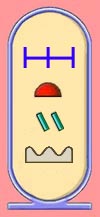 Semti |
 When king Den was old enough to take care of office from his mother, he soon became a great leader. He had a substantial length of reign, probably much longer then the 20 years he is given by Manetho. Many things remaining of him are found from all over Egypt, and he is by far the best documented of all kings from the first dynasty. His name was hardly pronounced "Den" the way he is usually called, and other names were Semti, Udimu and in the cartou- che left - Itiui. Zemti was spelled by a the hiero- glyphic sign for "high desert, foreign land or enemy" (at the bottom left), possibly to comm- emorate his deeds making campaigns against people at the northeast border as well as the desert mountains east of the Nile Valley.
When king Den was old enough to take care of office from his mother, he soon became a great leader. He had a substantial length of reign, probably much longer then the 20 years he is given by Manetho. Many things remaining of him are found from all over Egypt, and he is by far the best documented of all kings from the first dynasty. His name was hardly pronounced "Den" the way he is usually called, and other names were Semti, Udimu and in the cartou- che left - Itiui. Zemti was spelled by a the hiero- glyphic sign for "high desert, foreign land or enemy" (at the bottom left), possibly to comm- emorate his deeds making campaigns against people at the northeast border as well as the desert mountains east of the Nile Valley. One of these campaigns is depicted on a famous ivory label in British Museum.
Den had a prosperous time on the throne and art and economy seem to have flourished. Many innovations saw the daylight during his reign and he adopted the double crown to underline his dual kingship over the two countries.
His tomb at the royal burial ground at Abydos was an ordinary square monument, but had a new feature in form of a very long broad staircase leading directly to the grave chamber. This new architectural design was quickly adopted in the private tomb sector as well as the following kings. In the 1980s it was investigated once again and was found in a very good condition.
He is said to have improved the administration, and on the Palermo Stone is recorded that he had a census "of all people of the north, west and east" taking place in the country, obviously to see how many subjects he was ruling, and could make pay taxes.
About 30 great mastabas from his reign were built by officials from Sakkara and up north to Abu Roash. This was far more than during the reigns of his predecessors who only had a few built during their time on the throne.
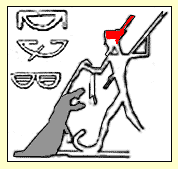 A remarkable seal impression from Abydos shows the king as golden statues, when carrying
out ritual activities like harpooning a hippopotamus (in picture left).
A remarkable seal impression from Abydos shows the king as golden statues, when carrying
out ritual activities like harpooning a hippopotamus (in picture left). A similar motif is found on a stone palette being hundreds of years older. This scene should last for thousands of years, even after that hippo was distinct from Egypt. It was probably made to tell that pharaoh was the protector of stability, and could through his strength successfully fight disorder.
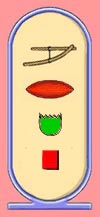 Meribiap |
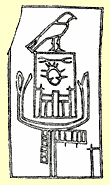 |
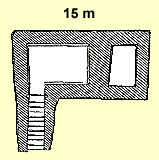 Besides there his name has only been found in two other places in Egypt: Abydos and Helwan,
and outside its borders possibly at En Besor in southern Palestine.
Besides there his name has only been found in two other places in Egypt: Abydos and Helwan,
and outside its borders possibly at En Besor in southern Palestine. At Sakkara a great mastaba, probably for his prime mini- ster, revealed a new architectural construction within when it was dug out in the 1950s. In contrast his own tomb in Abydos was a crude small construction (picture right) and so were the rows of 64 satellite tombs. This high number tells that though is reign seems to have been a step backwards for the country as a whole (inter- nal struggle?) the king's power over the commoners was unbroken.
The grave chamber still held parts of the wooden floor after 4.500 years.
Possibly trying to establish himself as the true king over all Egypt he adopted a new title - "The Two Lords". He thereby probably underlined his task not put any- one in favor of the of the gods Horus and Set whose supporters obviously had divided the country spiritually and created more or less social disorder and poli- tical instability. This continued well in to, and even to the end of the next dynasty. His power over the south was challenged by local tribes and the northern nomes were often rebellious.
Several stone objects have shown that the habit of making statues of the pharaoh had already began. They depict king Anedjib as a statue wearing various garments, and these probably stood in different temples.
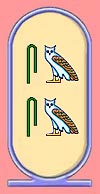 Semsem |
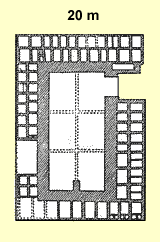 King Semerkhet was the fifth regent in the first dynasty and his personal nomen was Semsem (in cartouche left). He had the shortest time on the throne - eight and a half years. We know this for a fact because his complete reign is documented on the Cairo Stone in the Egyptian Museum. Regrettably the entries from each year are only about ceremonies of different kinds and do not record any historical events. Nevertheless do we have a figure of his age when he died, from the Turin Canon: 72 years.
King Semerkhet was the fifth regent in the first dynasty and his personal nomen was Semsem (in cartouche left). He had the shortest time on the throne - eight and a half years. We know this for a fact because his complete reign is documented on the Cairo Stone in the Egyptian Museum. Regrettably the entries from each year are only about ceremonies of different kinds and do not record any historical events. Nevertheless do we have a figure of his age when he died, from the Turin Canon: 72 years. Theories about his legitimacy to kingship suggesting that he was an usurper has been put forward by scholars because he had the habit of reusing his predecessor's goods. At the cemetery at Abydos objects from Anedjib's time (and tomb?) was found in Semerkhet's where he had erased the original name and replaced it with his own. In a seal from his successor his name is written in the line with the other kings, telling that he was recognized as a pharaoh at least by his follower, who was his son (according to Manetho).
A so called year label from Semerkhet reign was found at Abydos in his follower's tomb at the re-excavation in the mid 1990s made by DAIK, the German Institute of Archaeology in Cairo.
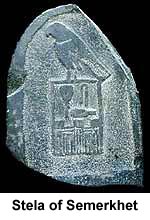 His tomb in Abydos (picture above right) shows a new feature:
retainers' tombs attached directly to the walls of his own, and a door entrance rather
then a staircase leading to the grave chamber. This means that the whole construction was
covered by one superstructure, indicating that the retainers were buried at the same
time, and thus probably sacrificed to the honour of their master.
His tomb in Abydos (picture above right) shows a new feature:
retainers' tombs attached directly to the walls of his own, and a door entrance rather
then a staircase leading to the grave chamber. This means that the whole construction was
covered by one superstructure, indicating that the retainers were buried at the same
time, and thus probably sacrificed to the honour of their master. Among the offering goods were found 10 vessels imported from Palestine when it was excavated by English Egyptologist Petrie in 1901. The foreign trade was kept up during his reign, but never reached the height it had during the middle of the dynasty. The only object of substance to have survived from Semerkhet's reign is a black granite funeral stele found by his tomb in 1898 (picture left). It had originally belonged to a pair erected outside his monument, a tradition from the very beginning of the dynasty to mark the place for offerings.
He is the first king who does not have a mastaba tomb from his reign at North Sakkara, and it's likely that his high officials survived his short reign and continued serving the next monarch. At least one of them is known by his name - minister Henuka.
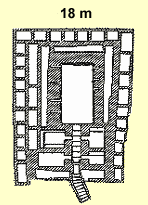 Pharaoh Qáa had the personal nomen Qebeh as seen within a cartouche in the picture at bottom right.
Pharaoh Qáa had the personal nomen Qebeh as seen within a cartouche in the picture at bottom right. He was the last ruler of the dynasty and according to Manetho he reigned for about 26 years, and this is likely because several mastabas at Sakkara are dated to his reign.
According to the Turin Canon his age when he died was 63 years and the length of his reign is not visible on the papyrus.
 In 1993 a German archaeological expedition re-excavated his tomb at Abydos and discovered that several
alterations had been made to the structure and undertaken over significant period of time. It is
one of the most impressive at the Abydos cemetery and after 4.500 years the funeral chamber still held parts of the wooden floor and traces of the colorful patterns on the walls. A fine artifact was found by archaeologist Petrie in 1900 (shown in picture left). It's a gaming rod made of ivory showing
a captive of war with his hands bound behind his back. A lot is pointing to that the depicted
man is from a tribe in the east, and the sign above is head is a very unusual hieroglyph that
in later times at least, stood for enemies from that direction. His large beard is a little too
much to come from an Egyptian, they used to shave themselves at least on their cheeks. Other
finds from his grave were three copper bowls with the king's name on them. The practice of subsidiary
burial where retainers were killed in order to serve the ruler in the afterlife ceased after
the reign of Qáa. The beginning of his reign is recorded on the Cairo stone, telling about his
ceremonial duties and founding of temples etc.
In 1993 a German archaeological expedition re-excavated his tomb at Abydos and discovered that several
alterations had been made to the structure and undertaken over significant period of time. It is
one of the most impressive at the Abydos cemetery and after 4.500 years the funeral chamber still held parts of the wooden floor and traces of the colorful patterns on the walls. A fine artifact was found by archaeologist Petrie in 1900 (shown in picture left). It's a gaming rod made of ivory showing
a captive of war with his hands bound behind his back. A lot is pointing to that the depicted
man is from a tribe in the east, and the sign above is head is a very unusual hieroglyph that
in later times at least, stood for enemies from that direction. His large beard is a little too
much to come from an Egyptian, they used to shave themselves at least on their cheeks. Other
finds from his grave were three copper bowls with the king's name on them. The practice of subsidiary
burial where retainers were killed in order to serve the ruler in the afterlife ceased after
the reign of Qáa. The beginning of his reign is recorded on the Cairo stone, telling about his
ceremonial duties and founding of temples etc.
Among the finds in his tomb in the 1990s was a seal impression with all the kings from the first dynasty up to Qáa himself was written down.
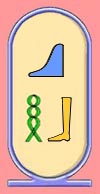 Qebeh |
Qáa is attested to the south from rock carvings near the old town of Hierakonpolis, and also mentioned on jar sealings and two damaged stele. Until the reign of Den Egypt seems to have enjoyed stability and prosperity, but during Anedjib's reign order broke down when conflicting fractions (Horus versus Set) caused changes that ended the dynasty.
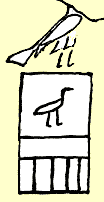 At the end of the first dynasty, there could have been (probably was) a number of ephemeral rulers. One of them might be the pharaoh with a bird within his serek, and known from only one single piece of evidence, coming from the galleries under the step pyramid from third
dynasty king Djoser at Sakkara. The object (partly shown in picture right) is from a stone vessel made
of schist with this king's name carved in.
His position is far from certain, but he is considered to have had a short reign at the end of
the second dynasty. This estimation is made by comparing his hieroglyphs' and
serek's form to those of other rulers at the time. One of them is a crude serek found in king
Qáa's tomb at Abydos in 1902 and possibly showing a bird. But it's hard to tell, and it is shown as example number 5 (below right) within a serek.
At the end of the first dynasty, there could have been (probably was) a number of ephemeral rulers. One of them might be the pharaoh with a bird within his serek, and known from only one single piece of evidence, coming from the galleries under the step pyramid from third
dynasty king Djoser at Sakkara. The object (partly shown in picture right) is from a stone vessel made
of schist with this king's name carved in.
His position is far from certain, but he is considered to have had a short reign at the end of
the second dynasty. This estimation is made by comparing his hieroglyphs' and
serek's form to those of other rulers at the time. One of them is a crude serek found in king
Qáa's tomb at Abydos in 1902 and possibly showing a bird. But it's hard to tell, and it is shown as example number 5 (below right) within a serek.
He must not be confused with the Horus Ba from dynasty 3 whose serek had a human bone, in one occasion together with a ram. (The sounds in Egyptian are similar in these two names).
 King Bird? |
 This is also (like king Bird above) a mysterious pharaoh belonging to the very end of the first dynasty, a period that obviously was a time of some instability in society. His name is only attested for twice - and both finds come from Sakkara.
This is also (like king Bird above) a mysterious pharaoh belonging to the very end of the first dynasty, a period that obviously was a time of some instability in society. His name is only attested for twice - and both finds come from Sakkara. One is a fragment of schist (pictures below right) found by British archaeologist Walter Emery in the debris at the escarpment north of King Djoser's funeral complex, when he was excavating mastabas from the first dynasty. (see Emery: Great Tombs III, pl. 38.1).
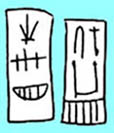 The serek (picture left) contains the hierogly- phic signs making up the king's name, but in a
slightly different order than in the other remnant confirming his existence - a stone vessel found under the pyramid of king Djoser and
published by Egyptologist Peter Kaplony in 1988 in MDAIK, which is the annual journal published by the German Archaeology Institute in Cairo.
The serek (picture left) contains the hierogly- phic signs making up the king's name, but in a
slightly different order than in the other remnant confirming his existence - a stone vessel found under the pyramid of king Djoser and
published by Egyptologist Peter Kaplony in 1988 in MDAIK, which is the annual journal published by the German Archaeology Institute in Cairo. His name is not recorded in any of the kings' lists (both official and from private tombs) made during the further 2.500 years the Egyptian state should exist. This probably means that he was unknown to later generations due to the fact that his reign was a very brief and insignificant one and the remains from his time on the throne were very few. That's the main reason why his position (together with the likewise obscure king Bird above) cannot be established with certainty, just estimated on brittle grounds.
The hieroglyphs building the phonetic sounds making his name Sneferka, might perhaps also be read as "Neferkaes" (the s-element being put last instead of first) and this would make it a female form of name.
This possibility has recently (2006) been proposed by the Italian scholar Francesco Raffaele (xoomer.virgilio.it/francescoraf/), and if correct, this would make her the first female pharaoh presented within a serek with the Horus-name and a falcon atop (above left).
2770 - 2649 BC (120 years)
The transition from first to second dynasty seems to have been smooth despite the disturbance noticed. The period is shadowy with social disorder and possibly civil war which might have split the nation in two halves for a time.
The first 5 kings and the last one are documented and positioned with accuracy but some chiefs in the mid period probably ruled for short terms and maybe from different parts of the country. At the end the union was recovered and the power was centralized to Hierakonpolis in Upper Egypt.
The table below gives the names from Manetho (re-writer Julius Africanus) and the three main Egyptian king lists: A temple wall in Abydos, a private tomb in Sakkara and the Royal Canon from the Papyrus of Turin. Manetho also gives the years in office. Notable: the Abydos list has just one king after Sened, the others have four.
| Archaeology | Manetho (Af.) | Abydos-Sakkara-Turin |
| 1 Hotepsekhemwy | 1 Boethos 38 | 1 Bezau, Neterbau, Baunetjer |
| 2 Nebre | 2 Kaiechos 39 | 2 Kakau, Kakau, Kakau |
| 3 Ninetjer | 3 Binothris 47 | 3 Baneteren, Baneteru, Banetjer |
| 4 Weneg | 4 Tlas 17 | 4 Uaznes, Uaznes, (unreadable) |
| 5 Sened | 5 Sethenes 41 | 5 Senedy, Sened, (Sendji?) |
| Nubnefer | 6 Khaires 17 | (Sealing: king "Kara" occurs once) |
| Neferkare | 6 -, Neferkara, Neterka | |
| Neferkaseker | 7 Nepherkeres 25 | 7 -, Neferkaseker, Neferkasekru |
| Peribsen (Sekhemib?) | 8 Sesochris 48 | 8 -, gap, gap |
| 10 Khasekhem(wy) | 9 Kheneres 30 | 9 Zasai, Bebi, Bebti |

The six cartouches of kings of dynasty 2 from the Abydos list:
Hotepsekhemwy, Nebre, Ninetjer, Weneg, Sened, Khasekhemwy.
 Bedjau |
 His Horus-name (in the serek right) means "the two powers are at ease" meaning that the struggle between the Horus and Set fractions in society was at peace. But this was hardly more than a hope from his side, because this conflict should be a burden for generations and nearly tore Egypt apart.
His Horus-name (in the serek right) means "the two powers are at ease" meaning that the struggle between the Horus and Set fractions in society was at peace. But this was hardly more than a hope from his side, because this conflict should be a burden for generations and nearly tore Egypt apart.He made a change in picking his place of burial left the traditional Abydos cemetery for a spot at the burial ground of the capital - in Sakkara. This was likely made as a political move, as a gesture of reconciliation in the internal political struggle, but to please whom, is not clear.
Not only did he change the place of burial - he made a totally new type of tomb with a revolutionary new design for his last resting place. It was a huge complex of underground galleries hewn out in the bedrock, a gigantic work of a type that never had been done in Egypt or anywhere else on Earth before. Indeed this was a total change and break through in the technique of stone cutting and a milestone in human progress. It was found merely by accident in 1902 a bit south of the Djoser complex by the Italian archaeologist Barsanti. In the almost empty tomb numerous seals with the king's name could be rescued, and thereby identifying the owner (see picture below left). The monument seems to be in an unfinished stadium though the grave chamber and its side room were completed.
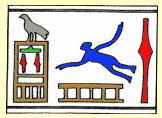 Around 20 minor rooms around the king's bedroom just might have been made for his staff of servants, but this is very hypothetical. Above ground nothing is left of a superstructure (if there ever existed one) and later buildings have been built upon it perhaps unaware of its existence.
Around 20 minor rooms around the king's bedroom just might have been made for his staff of servants, but this is very hypothetical. Above ground nothing is left of a superstructure (if there ever existed one) and later buildings have been built upon it perhaps unaware of its existence.After measuring the monument in 1902 it was closed and sealed, and it still awaits a real examination. The map drawn of its plan seem to be too symmetrical to be entirely correct.
According to Manetho king Hotepsekhemwy had a reign of 38 years (he is named in a Greek form: Boethos) and the Egyptian king lists calls him Bezau and Neter-bau. He is also attested by many inscriptions on stone vessels from the under- ground magazines under Djoser's pyramid. His name is also cut in to a granite statue of a long-lived priest and caretaker of his mortuary cult, who served under his two successors as well.
 Kakau |
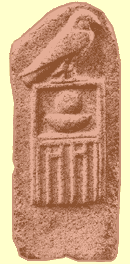 In the Turin Canon of kings he is noted by his personal nomen Kakau, seen within a cartouche in the picture left, symbolizing strength and virility.
In the Turin Canon of kings he is noted by his personal nomen Kakau, seen within a cartouche in the picture left, symbolizing strength and virility. In the Metropolitan Museum in New York is a fine stele made of red granite (in the picture to the right), and it is the most significant remain of him. Though found in the town of Mit Rahina in the flood plain (the place of the capital Memphis), the stele would have stood outside his tomb that obviously is to be found in the Sakkara area. A possible construction which can be the place of his last rest are the huge galleries cut out i the bedrock underneath the funeral complex of pharaoh Djoser. Another theory that has been put forward, is that he took over this big underground construction from his predecessor, and made it his own. In this case the galleries originally had to belong to someone else, who is up to now unknown to Egyptology.
By integrating the sun and its god Re in his own name, Nebre started a tradition that should last for over 2000 years.
An inscription on a black stone vessel (inverted picture below left) gives the correct position for the first two kings of the dynasty. Their sereks are put beside each other topped with the Horus falcon wearing the double crown and facing a goddess. Second in line after the founder of the dynasty is king Nebre.
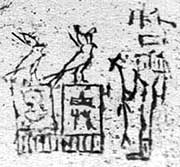 Manetho has a lot to say about him as a good complement to his rather sparse remains. He tells that Nebre started cults of different gods. In Memphis the emergence of worshipping the Apis bull is attested to him (but an inscription from first dynasty king Den tells that he was the one who started it 200 years earlier). In Mendes in the eastern delta he started the cult of the sacred goat and in the old solar cult center of Heliopolis 35 km north of the capital, he founded the worshipping of the bull Menvis.
Manetho has a lot to say about him as a good complement to his rather sparse remains. He tells that Nebre started cults of different gods. In Memphis the emergence of worshipping the Apis bull is attested to him (but an inscription from first dynasty king Den tells that he was the one who started it 200 years earlier). In Mendes in the eastern delta he started the cult of the sacred goat and in the old solar cult center of Heliopolis 35 km north of the capital, he founded the worshipping of the bull Menvis. Manetho also states that Nebre's reign was 39 years long, and he calls him by a Greek form - Kaiechos, a name closely corre- sponding to the name he's got in Egyptian king lists: Kakau.
His seal impressions have been found in the tomb of his predecessor Hotep- sekhemwy and at the southernmost site - a rock carving from the desert east of Armant in Upper Egypt, just by the route to the big oases in the Western Desert.
 Historian Manetho gives Ninetjer a reign of 47 years and calls him in a Greek way - Binothris. The Turin Canon does not note the length of his reign, but has the figure 95 clearly visible, possibly his age. The change to a b-sound in his name was made in later times when an additional sign (a ram) with that value was put to the king's name. Writings from his own time only contain the flag and the weavy line (serek in picture right).
Historian Manetho gives Ninetjer a reign of 47 years and calls him in a Greek way - Binothris. The Turin Canon does not note the length of his reign, but has the figure 95 clearly visible, possibly his age. The change to a b-sound in his name was made in later times when an additional sign (a ram) with that value was put to the king's name. Writings from his own time only contain the flag and the weavy line (serek in picture right). Later Eygptian canons spell his name: Baneteren, Baneteru and Neteren. The cartouche from the Abydos list in picture left says Banetjer, meaning "The Ram Of The God".
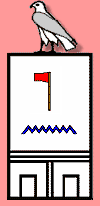 He is the best known of all kings from this early part of the second dynasty. Sealings with his name have been found in various places in Lower Egypt and most of all in Sakkara where one "nobility class" mastaba at the north escarpment contained half a dozen. It probably belonged to one of his high officials. His name has also been found in a big mastaba from Giza, but only at one occasion in Upper Egypt - at Abydos. It was found on stone vessels from the tomb of the later king Peribsen who possibly had brought them down south from the Memphis area.
He is the best known of all kings from this early part of the second dynasty. Sealings with his name have been found in various places in Lower Egypt and most of all in Sakkara where one "nobility class" mastaba at the north escarpment contained half a dozen. It probably belonged to one of his high officials. His name has also been found in a big mastaba from Giza, but only at one occasion in Upper Egypt - at Abydos. It was found on stone vessels from the tomb of the later king Peribsen who possibly had brought them down south from the Memphis area. Apart from all stone vessels his name only appears twice on other types of objects: a small ivory label and a famous statuette of stone. This fine cut little piece (picture below left) measuring 13,5 cm in height and 8,8 x 4,8 cm at the base, is made of a hard alabaster-like stone with a sheen towards greenish-yellow. It shows the king sitting on his throne wearing the white crown of Upper Egypt and at his chest he's holding the crook and the flail. He is dressed in a tight fitting robe and this garment is usually connected with the Sed-festival that took place every 20th year. He looks like a man in his older days. At both sides of the base his name is written in hieroglyphs not framed by a serek as shown in upper left corner of the picture.
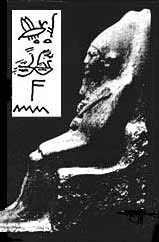 Most of the knowledge about his deeds comes from the Palermo stone where his name is written above the boxes with the annual events. These entries are from his 6th to his 20th year on the throne. Writing on stone vessels from Sakkara suggest that his reign was at least 35 years long since a notation says that the biennial census had just been executed for the 17th time.
Most of the knowledge about his deeds comes from the Palermo stone where his name is written above the boxes with the annual events. These entries are from his 6th to his 20th year on the throne. Writing on stone vessels from Sakkara suggest that his reign was at least 35 years long since a notation says that the biennial census had just been executed for the 17th time. The notations about different celebrations are all except one referring to events from Lower Egypt. There are records of political events too, because in his 13th year in office he ordered his military forces to attack two unidentified towns (Sm-r and Há).
The name Há can also be read "northern land" suggesting a rebellion from some places in the delta, or disorder at the northern frontier.
Ninetjer's tomb has been found in Sakkara just south of Djoser's pyramid complex and about 150 m beside the tomb galleries of the founder of the dynasty - Hotepsekhemwy.
Comparing both structures gives at hand that Ninetjer's is considerably smaller and more irregular with corridors and rooms cut out almost randomly, maybe because bad quality in the bedrock in some parts. The galleries from older king are, as they are depicted from sketches made in the beginning of the 1900s, almost too symmetrical and probably not entirely correct. One thing the tombs have in common: unfinished corridors. Possibly the work went on as long as the pharaoh lived starting with the essential parts, and then finally ceased when he died.
After Ninetjer something drastic happened to the Egyptian society which made many central functions collapse or decline for a short time. During this period of unrest a few names appear in fragmentary remains and among them a rather obscure king called Weneg, by some indentified as the ruler to come next, Sened.
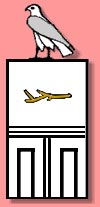

He was probably preceding pharaoh Ninetjer, at least in Lower Egypt, because a division of the country for a period cannot be excluded. The Turin Canon has an entry with an illegible name possibly to be his with no figure for the length of the reign, but one for the age of this king when he died: 54 years.
His Horus-name (in a serek) is not known, but can be written by a single branch (picture upper left). Other forms are found in a dozen inscriptions, most of them from Sakkara, with his name written by a single flower. Though his reign probably was a very short one (perhaps not more then a couple of years) his name is recorded in later king lists like from the temple in Abydos (picture upper right) and the Sakkara list (picture below left). This indicates that despite the lack of earthly remains he probably had a position in the legends for later generations, when they were commemorating the pharaohs from the past.
 The scribes at that time misread his flower-sign (to be read: WNG) and replaced it with a papyrus plant (picture left) giving the sound: Wadj-nes, meaning "fresh of tongue". This was translated Greek as "ougot-las" by the historian Manetho, who gave the king the name Tlas. In other words - a corruption on more than one occasion during the flow of time.
The scribes at that time misread his flower-sign (to be read: WNG) and replaced it with a papyrus plant (picture left) giving the sound: Wadj-nes, meaning "fresh of tongue". This was translated Greek as "ougot-las" by the historian Manetho, who gave the king the name Tlas. In other words - a corruption on more than one occasion during the flow of time.Because he had a very short reign we can hardly expect that his tomb is a mass of underground galleries like some of his prede- cessors. If he hasn't taken over an older construction and made it his own we can look for a monument of more modest size, maybe a mastaba of substance.
The area where to look for his tomb is probably around the other galleries east of the pyramid of king Sekhemhkhet. This monument lies where the topography is unsuitable.
A good guess might be that the area to the east already was occupied by superstructures (mastaba-like?) from dynasty 2 tombs, and that these were removed in later times.
The substructures should then still be detectable, but this place has not been properly investigated. There are candidates to be his tomb and in one mastaba (S3014) has even Weneg's name been found.
When pharaoh Sened was in power Egypt was probably divided once again into its southern and northern parts, with him as the king in North (Lower) Egypt from the capital Memphis. In the Turin Canon the length of his reign is lacking but a notation of (at least) 70 years indicates his age when he died.
 There are no contemporary remains of him, not even the smallest writing is found so far.
A possible exception is a block of stone with his name on it, that was found and reused as building material in the mortuary temple of fourth dynasty king Khafre (Khefren) at Giza. This piece might just be of second dynasty origin and thus contemporary to Sened.
There are no contemporary remains of him, not even the smallest writing is found so far.
A possible exception is a block of stone with his name on it, that was found and reused as building material in the mortuary temple of fourth dynasty king Khafre (Khefren) at Giza. This piece might just be of second dynasty origin and thus contemporary to Sened. Another remain with his name is from a private fourth dynasty tomb in Sakkara where a man called Shery has a title that tells that he is connected with the cult commemorating king Sened. This is a couple of hundred years after his death. The text also mentions king Peribsen who probably was Sened's counterpart in the southern part of the country at the same time. All other material sources science have about him are made in later times and one remarkable object is a statuette from 2000 years after his death made in the 800s BC.
 Though considered to be very insignificant by today's Egyptologists since he has left no remains of substance anywhere in Egypt, he obviously had a strong position in the minds of later Egyptian generations. The reason for this is so far concealed to science. Another fact pointing in the same direc- tion is that he was put in to the king-lists among the much more famous colleagues of his. His name thus appears in the Abydos list (picture above right) and in the canon from a private tomb in Sakkara where he is depicted simply by a plucked goose (pic- ture left). He is mentioned in the Canon of Turin as well, also there as a plucked goose.
Though considered to be very insignificant by today's Egyptologists since he has left no remains of substance anywhere in Egypt, he obviously had a strong position in the minds of later Egyptian generations. The reason for this is so far concealed to science. Another fact pointing in the same direc- tion is that he was put in to the king-lists among the much more famous colleagues of his. His name thus appears in the Abydos list (picture above right) and in the canon from a private tomb in Sakkara where he is depicted simply by a plucked goose (pic- ture left). He is mentioned in the Canon of Turin as well, also there as a plucked goose.Historian Manetho gives him a reign of 41 years and calls him Sethenes. If that name has something to do with the god Seth we don't know, but Egyptian records only call him Sened. His tomb has not been identified yet, but if his reign was that long he surely had the time to construct a monument of some dimen- sions.
The man mentioned above working with his mortuary cult, probably had his tomb a bit north of Djoser's complex, and the galleries west of his pyramid are a possible monument of Sened's and of other kings as well.
The answer might be given when the whole Sakkara necropolis is excavated some day, because many monuments are expected to be buried there.
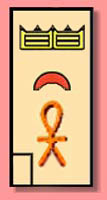 Hewet Menet Ankh |
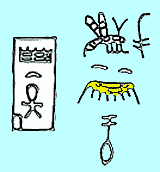 His Horus-name (within a serek) has not been found but there might be a possibility though in the standing rectangle on the same fragment which gives the name Hewet Menet Ankh (left).
His Horus-name (within a serek) has not been found but there might be a possibility though in the standing rectangle on the same fragment which gives the name Hewet Menet Ankh (left). If this is his Horus name or if his so called nesy-bity name (Nubnefer) is from another ruler, known by another name or unknown, we do not know. Pharaoh Nebre is the one who has been put forward as a can- didate by some in this case of name riddle.
The German Egyptologist Helck made careful estima- tions in the 1970s about Nubnefer's position, and came to the conclusion that he reigned very close to king Ninetjer, after or before. His time in office seems to have been a very short one, and nothing is mentioned about him after his death, not even indirectly.
One theory among others is that Nubnefer was the nesy-bity name of king Nebre (the predecessor of Ninetjer), due to the fact that this name of his has never been found. If so, whose name is Hewet Menet Ankh written beside Nubnefer's?
The king Khaires from Manetho's list fits the best to Nubnefer only by its place and the following names, but the reign of 17 years is hard to believe unless his remains were deliberately erased by his followers. Kaires can be of another mysterious king who came to light on a sealing in El-Kab found by the English Egyptologist Flinders Petrie. (Scarabs and Cylinders' pl. VIII; id. 'History' p.26). This name can also be read - Kara, (with the corresponding element KA and R to Kaires) and this single piece of clay is the only proof of his existence.
As to Nubnefer's tomb, it is probably to be found within the necropolis of Memphis at the Sakkara burial ground, where the so called "hot area" where Weneg, Sened and possibly other kings are expected to rest. Because of his (presumed) short reign it's likely to be a monument of modest size, if it still exists or ever was.
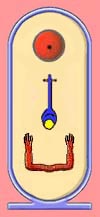 There are no contemporary remains from king Neferkare unless he is identical to king Nubnefer (above) and the two remains from him. Several rulers have had this name and the sound elements building up the name are very common.
There are no contemporary remains from king Neferkare unless he is identical to king Nubnefer (above) and the two remains from him. Several rulers have had this name and the sound elements building up the name are very common. Archaeologists know him only from the two king lists from Áaka's tomb at Sakkara and the inscription in the papyrus from Turin known as the Royal Canon of Turin. In the third list of substance - the Abydos king list from a wall in the temple of king Seti I from the 19th dynasty, he does not exist and nor does his immediate successor. This temple is from 1200 years after the second dynasty and so are the other two lists. If the omission of him and his successor has to do with a tradition in Abydos (with hostility to the northern Memphis area during the second dynasty) we don't know.
In both the Sakkara list and Turin canon he has the position between Sened and Neferkaseker and in Manetho's list he is in the same place under the Greek-formed name Nepherkheres which is the next king in line (se below) Neferkaseker. Since their names differ from one another with just a phonetic sign it's a theory that it is one and the same king with different spellings of his name.
At the end of the Old Kingdom around dynasty 6 his name comes to light during several rulers. This shows that he and other more or less unknown kings from the same time, were far from forgotten by the generations that follow them. The picture to the right shows the cartouche with Neferkare's name as it appears in the Sakkara list. It contains the signs KA with the raised arms (meaning soul) and NEFER (a sign possibly showing a belly and a windpipe) meaning beautiful and the sun symbolizing the solar god Re. These signs are by far the most common in names from pharaohs.
If Neferkare and his colleges Nubnefer above and Neferkaseker below, was ruling ahead or after the better known kings Weneg and Sened, is a question not solved by the scholars. Egypt might even have split up in two parts with these two ruling the north, since their names have only been found in the memphite area.
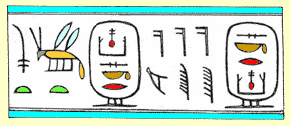 Three kings after Sened are not present on the Abydos temple wall, and one of them is Neferkaseker.
Three kings after Sened are not present on the Abydos temple wall, and one of them is Neferkaseker. In the Sakkara list (from the private tomb of a man called Áaka) and in the royal Canon from the Turin pa- pyrus he is shown by his Neswybity-name within a cartouche, but his Horus name within a serek is yet to be found.
His reign is noted for 8 years and three months, but a note of his age is lacking.
A cylinder seal impression from him found in an unknown place in the Nile Valley shows good similarities in style and composition to the one of Peribsen from Milan, a piece that has been questioned. If this impression containing two car- touches with his name written in different ways (picture above right) is genuine and contemporary, it would be the second oldest known cartouche with a king's name found in Egypt so far.
Being a pharaoh not so well known (i.e. more or less unknown), Egyptologists have recovered a remarkable papyrus fragment from the second century A.D. written by demotic hieroglyphs.
 It deals with prospecting a temple in the Faiyum area and has a visible though damaged text (picture left) which has been read:
It deals with prospecting a temple in the Faiyum area and has a visible though damaged text (picture left) which has been read: Up to now (year 2001) there has been no trace of this king what so ever from any kind of monument and this makes this papyrus fragment even more mysterious.
 An inscription rather similar to this has been found on one occasion though, with hieroglyphs making: Neferkaseker Nefer (shown in picture right).
An inscription rather similar to this has been found on one occasion though, with hieroglyphs making: Neferkaseker Nefer (shown in picture right).It was found at the beginning of the 1900s when Italian arch- aeologist Barsanti was clearing the remains of the supposed fourth dynasty pyramid at Zawiyet el Aryan, the very big so called "Unfinished Pyramid" (see king Bikka of dynsaty 4). Most fragmentary finds with names from this pyramid were written within or beside a cartouche, but these very signs have no such component and cannot be considered as a king's name with certainty.
Sekhemib Perenmaat is an illusive ruler from the later part of this dynasty.
He could either have been a separate king, or he may have not existed at all, just being another and earlier name of king Peribsen (see below).
No monuments of any kind throughout Egypt can be attested to Sekhemib.
At Saqqara eight fragments of stone have his name, and most prominent vessels from the Step Pyramid complex around the eastern galleries. The fact that many of his seal impressions are found in Peribsen's tomb suggests that it's a single king having two names. If so it would be a unique occasion in Egyptian history.
Sekhemib thus changed his name to Peribsen and put the Set-animal on top of his serek. He thereby announced which side he was on in the domestic struggle going on between supporters of Horus and Set.
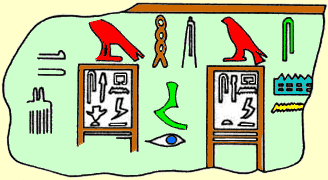 |
A seal impression bearing the name of Sekhemib Perenmaat shown within a royal serek. Many others are found at Peribsen's tomb (Abydos cemetery), eight pieces from Sakkara (under Djoser's step pyramid) and a single one from the town of Aswan. |
Today this theory is less plausible than during the 1950s because new finds speak against it. Peribsen's name hasn't been found on contemporary monuments in Saqqara. If this is a fact based on deliberate exclusion of things coming from a "rebellious" ruler, or just a historical coincidence, we do not know for the moment (year 2004) and is anybody's guess.
That he might have ruled in between Peribsen and Khasekhemwy is supported by the discovery of a fragmentary seal impression with his name in latter's tomb at Abydos. It was found by the German Archaeologists in the 1990s, and this fits with the lost name (Hudjefa, in menu left and below) from the Royal Canon of Turin, which might be him.
Though he is likely to have ruled just for a brief period, his tomb should be among the others at the Royal cemetery at Abydos, but so far (year 2010) it hasn't turned up from under the sand - if it ever was there.
The single pieces to establish his correct position are very few and hopefully new parts will appear to complete this jig-saw puzzle.
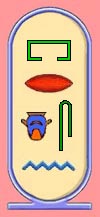 Peribsen |
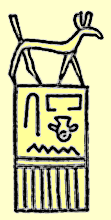 Peribsen was a ruler who had his roots in the South, and was probably ruling from there throughout his time on the throne. Not a single trace of him is found in Lower Egypt with an exception of a writing with his name found in Sakkara and brought there in later times. He was the first king to write his name within a cartouche as seen in the picture left where his personal nomen is written.
Peribsen was a ruler who had his roots in the South, and was probably ruling from there throughout his time on the throne. Not a single trace of him is found in Lower Egypt with an exception of a writing with his name found in Sakkara and brought there in later times. He was the first king to write his name within a cartouche as seen in the picture left where his personal nomen is written.He made a remarkable change in royal tra- dition by putting the god Set on top of his serek, (picture right) thereby disregarding the old southern Horus falcon that from ear- liest times had been the symbol of pharaoh. This move was obviously a political and religious statement and he thereby took side in the ongoing conflict between the supporters of these two gods which had divided an weakened the two united states.
Thus he might have been a ruler just over the southern part of the country (Upper Egypt), for a period estimated to have been for around seventeen years.
A king called Sekhemib-Perenmaat (see above) might have been a separate ruler, but most scholars take the view that this was the name of Peribsen before his "conversion". "King Sekhemib" thus has no tomb in Abydos but the name has been found on labels in the area inside and outside Peribsen's tomb.
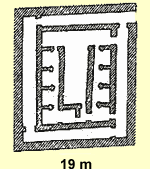
When he became king of Upper Egypt it might have been after civil war against Lower Egypt. His opponent might possibly have been king Sened and these two thus ruled each part of the Nile Valley. At some point Peribsen took over the whole country. We know this from inscriptions coming from his tomb in Abydos that tell about tribute (or conqueror?) concerning the town of Sethroë in the delta.
From a civil tomb in Sakkara a couple of hundred years later a caretaker from the cult of Sened also had the duty to oversee the veneration of Peribsen, though he was buried in the other part of the country. This can be seen as an act of reconciliation by the following generations thereby avoiding to split up the nation again.
Peribsen's tomb (picture above left) is a traditional square building and it stands alone without any side burials. This means that by this time the tradition of sacrificing(?) (side burials) of retainers had ceased. Outside his monument two inscribed stele were erected of which one has survived. He also followed the tradition from the other kings buried at Abydos by building an enclosure. These buildings had ritual purposes and were connected with the tombs and cult of the dead pharaohs.
At the end of the second dynasty the Royal Canon of Turin has a notation of a king whose name is lost. Disorder and probably civil war was present in Egypt during this time and the fighting was possibly spread all over the country and ended in a north-agains-south manner with the religious/political tensions still present affter the open fighting.
Anyhow accordig to this breef entry in the list of kings, this ruler seems to have entered office at the age of around 25 and after a reign of eight years and four months he died 34 years young.
Maybe his name is known today from the scattered finds of otherwise unknown rulers, but Egyptologists do not know that just he's the missing name in the list.
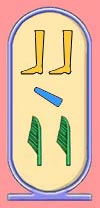 Beby |
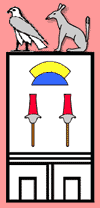 The most outstanding figure from the second dynasty and probably the whole Early Dyna- stic Time, was pharaoh Khasekhemwy.
The most outstanding figure from the second dynasty and probably the whole Early Dyna- stic Time, was pharaoh Khasekhemwy. In the cartouche left is shown his personal nomen Beby, and he really should have the title "Unifier of the two countries".
At the Turin Canon he is noted for a reign of 27 years, 2 months and 1 day and when he died he was at least 40 years of age.
After winning the struggle against the North that had started during the reign of his pre-decessor, he chose Hierakonpolis in the far south to be his capital and it was the first and last time the united Egypt was ruled from there. It took some effort to win the war and inscriptions from granite vessels found in his capital tell about his fights with the people from the north, described as "rebels".
Being diplomatic he did not favor any of the main gods Horus and Set when the military struggle was over. He simply put them both atop of his serek (picture right), thereby hoping to make peace and order to the country. He also changed his name putting to it an additional -WY making it say - "The Two Powers Come Forward", instead of the single one (as Horus) that he had before. In consequence he also put another commander's staff to his serek thereby making his new polit- ical view visible. He also made a campaign in to Nubia and adopted a new title: "overseer of the foreign lands" which shows his interest to keep contact abroad. His names have thus been found all the way up to Byblos in Syria.

His tomb is founded a bit away from the others in Abydos is a remark- able construction (picture left) unlike any of the earlier monuments there. The design is a somewhat (diplomatic?) mixture between the northern style mastaba tombs and the traditional square buildings from the south. On top of all he placed it on "neutral" ground some 200 metres aside (south of) the old cemetery. He also kept the tradition from most of the earlier kings by making an enclosure 1,8 km towards the Nile from his tomb, probably for rituals of his mortal cult.
The size was far bigger than his predecessors: 69 metrs in length and 10-17 meters wide made of walls a good 2 meters high. When it was excavated in 1900 it still contained half a dozen implements such as chisels and woodcutting tools made of copper. In the middle was the grave chamber built in stone, the first of its kind. The ability to handle this material was shown for the first time in Egyptian history by the statues of Khasekhemwy which luckily have survived from a find in Hierakonpolis. If they are portraits more than idols images, the king seems to be a man with a deter- mined look on his face, and a firm mind, and this seems to have been the charac- teristics of the king.
The most striking remain from him is the huge building he made at the capital Hierakonpolis. On the western side of the Nile a bit into the desert lies the oldest known monumental building of sun-dried bricks in Egypt. It is the so called Fortress with its gigantic structure. The purpose of it is somewhat disputable and varies from a fort to protect the capital from enemies to a ceremonial enclosure for different rituals connected to worshipping of gods or mortuary cults of the dead pharaohs.
 |
| Horus-Seth Khasekhemwy Hotep Netjerwy Imef. (Two powerful ones have risen and the two lords are at peace within him). |
The measurements are approximately 67 by 57 meters and though in a state of ruin - the massive walls are of dimensions not found in Egypt ever since - 5 meters thick and still today standing up to 11 meters high.
The most remarkable remain thought to be his is the very large rectangular enclosure at West Sakkara and today called Gisr el-Mudir. Excavated in some places during the 1990s it turned out to hold a stone cut wall. In some places the height was 4,5 meters in 15 cores and the base width of 15 meters suggests a much greater height when it was finished. The monument measures about 600 x 340 meters with an entrance from the south side. There is no trace of any buildings within the walls which are constructed with a lining of hewn stones and a core made of rubble and sand. This filling has revealed remains from dynasty two, indicating that the building is older than Djoser's Step Pyramid nearby.
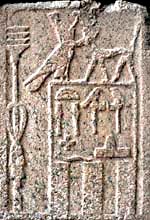 |
| Serek showing Horus and Set kissing! |
A connection to the coming king Djoser has been shown by findings outside the door of Khasekhemwy's tomb at Abydos where lots of seals bearing the name of this later ruler came to light in the 1990s, unearthed by German archaeologists. This shows that kings were firm on keeping the mortuary cults of their predecessors, since there seems to be a time gap for at least half a century between the two.
Khasekhemwy's gifted politics made the different parts of society flourish and his work was a turning point in the development of Egyptian history. His name has been found as far away as in Syria in the north where his later (-wy) name is seen on a bowl with Set and Horus atop (Montet 1928, page 84).
He laid the ground to the golden days that were to come, and later generations were in great debt to him for their wealth. We do not know if he left a son to take over the throne after him and his connection to the following rulers is obscure. They started a new chapter in the history of mankind leading to a new type of tomb buildings later to be known by its Greek name and these were the Pyramids.
This coming glorious period is called:
The Old Kingdom
-->